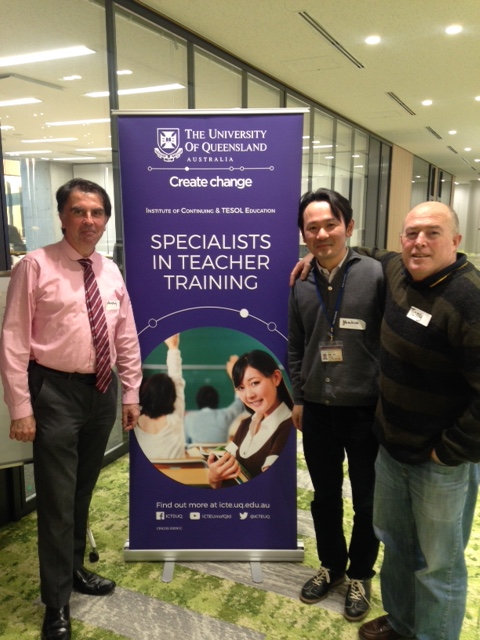CLIL
Workshop at Meijo University, Nagoya.
1st December saw the start of a two-day workshop
on English language teaching at Meijo University. The coordinator
was Philippa Coleman, a teacher at the University of Queensland,
Australia. A group from AUE, Anthony Ryan, Anthony Robins and Taka
Nagamine, joined the first day which was all about Content
Integrated Language Learning (CLIL).
CLIL was first proposed in Europe in the 1990’s to encourage a
pluralistic view of language - so called ‘multilingualism’. It was
introduced to Japan later, and it has only been a few years since
it became popular. Philippa is an experienced English teacher and
a teacher trainer who has travelled to many countries, and she has
provided very insightful and practical ideas of what CLIL is and
how it should be introduced to Higher Education including
university.
The workshop itself was a demonstration of CLIL, namely, teaching
content in another language. When it comes to teaching content,
you might want to name English as a medium of instruction (EMI),
but Philippa argued that it is clearly different as CLIL is a
pedagogical/teaching method, not just a way of instruction. She
also briefly touched upon the crucial ‘4Cs’ in CLIL - Content,
Communication, Cognition, and Culture. Plus, her practice at UQ
includes 3 ‘pillars’, rather than the 4Cs - Content, Language, and
Learning skills, which explain what abilities students would need
for full understanding. If any of the three pillars collapse, CLIL
would not work well in a classroom. The three pillars make it
explicit what teachers expect students to gain; CLIL is for
developing students’ understanding of the contents and the
language, as well as effective learning skills.
However, it is easier said than done. The participants then
discussed the difficulties in introducing CLIL to their
institutions from perspectives of 1) Academics & Teaching, 2)
Students & Learning, and 3) Institutions. We agreed that a
majority of members at an institution should understand what CLIL
is and what benefits everyone can receive. The possible barriers
discussed were how people at administrative level understand CLIL,
what is the appropriate level of English of teachers, and how we
can raise students’ awareness of language.
The workshop seemed to be very successful, and I also learned a
number of things. The most important thing may be that we have to
consider the way we approach students, since Japanese
students are traditionally used to sitting in a lecture, taking
notes very hard, and being all ears about what teachers say. In
fact, I feel like there is nothing special needed in introducing
CLIL - all we need is to think about is how we can get students
involved actively, and how we can let them do things by
themselves. Of course the name CLIL sounds very fancy and would be
very useful to pick up a well-established theory when we have to
change something. However, what we need to change is our attitudes
- some of the lecturers, including the two gentlemen who were with
me, have long done this!

Colleagues
past and present. Yasuhiro Fujiwara and Tony Ryan with me at the
CLIL teacher training event at Meijo University on 1st December.
Find out about our CLIL Research in Hong
Kong.


